|
|
|
Some thoughts on the history of
The Tracing Boards
PART FOUR
|
Presented at the Vancouver Grand Masonic Day, October 16, 1999
by Bro. Mark S. Dwor, Centennial-King George Lodge No. 171
CURRENT TRACING BOARD USAGE
Finally, I am enclosing probably the most famous of the Tracing Boards, done by Harris for the Emulation Lodge of Improvement dated 1845. It is these and other ones that he did that have been copied and adulterated which we now we use as our Tracing Boards. (see figs. 19, 20, 21.)
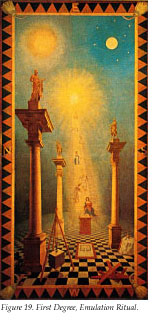 There’s another artist, Thissleton, who I have not included because the quality of the reproduction wouldn't have been very good and there was nothing particularly interesting about his artwork. There are some other unnamed artists that I also cannot reproduce. I have, as much as possible, avoiding dealing with wall hangings and other Masonic wall charts and Royal Arch Tracing Boards &c., &c. Those are subsidiary topics to what I'm dealing with and this is complicated enough.
I've also left out references to other similar Tracing Boards (the Harris designs) because frankly they haven't been reproduced by either Haunch or Dring. Both of them decided not reproduce them for particular reasons which I believe are worth sharing. First from Dring and then from Haunch as follows:
"I have tried to put before you as concisely as possible the Evolution and Development of the Lodge Board, and I have purposely refrained from entering into the later developments made by Harris and the designers of the Victorian era. They form a distinct chapter which would entail little labour for any brother to write, but I must say the subject does not interest me. Erroneous ideas, mistaken conceptions, meticulous details, in fact, all the bad qualities of the Victorian age permeate them, and, to my idea, the sooner we return to the pure realistic designs of Bowring or some of his contemporaries the better." There’s another artist, Thissleton, who I have not included because the quality of the reproduction wouldn't have been very good and there was nothing particularly interesting about his artwork. There are some other unnamed artists that I also cannot reproduce. I have, as much as possible, avoiding dealing with wall hangings and other Masonic wall charts and Royal Arch Tracing Boards &c., &c. Those are subsidiary topics to what I'm dealing with and this is complicated enough.
I've also left out references to other similar Tracing Boards (the Harris designs) because frankly they haven't been reproduced by either Haunch or Dring. Both of them decided not reproduce them for particular reasons which I believe are worth sharing. First from Dring and then from Haunch as follows:
"I have tried to put before you as concisely as possible the Evolution and Development of the Lodge Board, and I have purposely refrained from entering into the later developments made by Harris and the designers of the Victorian era. They form a distinct chapter which would entail little labour for any brother to write, but I must say the subject does not interest me. Erroneous ideas, mistaken conceptions, meticulous details, in fact, all the bad qualities of the Victorian age permeate them, and, to my idea, the sooner we return to the pure realistic designs of Bowring or some of his contemporaries the better."
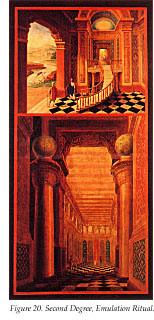 "In their basic design, Harris' boards owe much to those of his predecessors, particularly Bowring, although they lack the purity of style and balance of the latter’s work. The later examples exhibit the florid exuberance of ornament beloved of Victorian taste, especially the Second Degree Board, whose architecture is often a strange amalgam of Egyptian, Assyrian, Moorish and other styles."
I do not want to spend too much time on the "iconography" of the Tracing Boards, because the use of two hundred years ago is a separate topic completely, especially because some of the symbols have not been used in English Masonry since the Lodge of Reconciliation although they are still being used in other parts of the world. I cannot however leave this without discussing at least one point of interest in each of the three Tracing Boards. In regard to the First Degree Tracing Board, I refer to Browne Jacob and Harris , because each of them has a Tracing Board for the Master to write lines on and in fact, both Browne and Jacob show the 47th proposition.
In regards to the Second Degree Board, you will notice, if you look carefully, that some of the stairs wind to the right and some of the stairs wind to the left. This has sparked some debate as to which is the more accurate description of the stairs–I haven't even mentioned these references because it is not a topic that I find particularly worthwhile to investigate. There is, however, the issue as to what each Lodge felt was the proper direction for the stairways to go, and if you look at all the Second Degree Tracing Boards, except the first one by Cole, there are no compass points on them; this would allow the Lodge to have the Tracing Boards turned such that the stairs went whichever way the Lodge determined they should be going. "In their basic design, Harris' boards owe much to those of his predecessors, particularly Bowring, although they lack the purity of style and balance of the latter’s work. The later examples exhibit the florid exuberance of ornament beloved of Victorian taste, especially the Second Degree Board, whose architecture is often a strange amalgam of Egyptian, Assyrian, Moorish and other styles."
I do not want to spend too much time on the "iconography" of the Tracing Boards, because the use of two hundred years ago is a separate topic completely, especially because some of the symbols have not been used in English Masonry since the Lodge of Reconciliation although they are still being used in other parts of the world. I cannot however leave this without discussing at least one point of interest in each of the three Tracing Boards. In regard to the First Degree Tracing Board, I refer to Browne Jacob and Harris , because each of them has a Tracing Board for the Master to write lines on and in fact, both Browne and Jacob show the 47th proposition.
In regards to the Second Degree Board, you will notice, if you look carefully, that some of the stairs wind to the right and some of the stairs wind to the left. This has sparked some debate as to which is the more accurate description of the stairs–I haven't even mentioned these references because it is not a topic that I find particularly worthwhile to investigate. There is, however, the issue as to what each Lodge felt was the proper direction for the stairways to go, and if you look at all the Second Degree Tracing Boards, except the first one by Cole, there are no compass points on them; this would allow the Lodge to have the Tracing Boards turned such that the stairs went whichever way the Lodge determined they should be going.
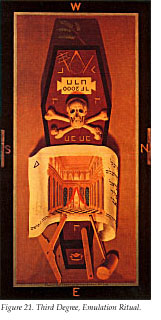 As for the Third Degree Board, what initially strikes one is the coffin. Hiram Abiff would have been buried only in a shroud not a coffin but the visual representation of the coffin has been kept consistent by and large. There was another confusing issue that I must deal with here and that is the lettering on the Third Degree Board itself. On some of the boards there is a little bit of Hebrew lettering but on most of the boards that are used in this jurisdiction, the lettering that is on the coffin or around the coffin is not Hebrew at all but a cypher which typically includes the Masonic year. As for the Masonic year, if you are interested in tracing this, the best article I could find was "The Dating of the Masonic Records," by Alan Bernheim, AQC Vol.99 (1986). As for the cypher, I enclose a copy of part of the Haunch article in which he explains how to read the cypher. (see fig. 22.)
Having said all of that I now enclose a Harris Third Degree Board that does not conform to much of what I just said. First of all it shows an open grave with a body in it, not a coffin, secondly, there is a fair amount of Hebrew on the tombstone (another uncommon feature). In fact, the only cypher on there are the six lines directly below the 47th proposition on the left hand side of the tombstone. The three Hebrew letters that are placed adjacent to North, South and East are identical and each has a numerical value of 5. It is typical to see three 5s on these boards in relationship to the Hiramic Legend. (see fig. 23.)
I believe this covers off the majority of the knowable history of Tracing Boards, and I now deal with the final questions as to why it is that we have Tracing Boards in our Canadian Work and how it is that we use them.
To some extent this can be traced back and through some work done by the Special Committee on Rituals between 1950 and 1954. I quote from the 1950 Grand Lodge Proceedings (page 131): As for the Third Degree Board, what initially strikes one is the coffin. Hiram Abiff would have been buried only in a shroud not a coffin but the visual representation of the coffin has been kept consistent by and large. There was another confusing issue that I must deal with here and that is the lettering on the Third Degree Board itself. On some of the boards there is a little bit of Hebrew lettering but on most of the boards that are used in this jurisdiction, the lettering that is on the coffin or around the coffin is not Hebrew at all but a cypher which typically includes the Masonic year. As for the Masonic year, if you are interested in tracing this, the best article I could find was "The Dating of the Masonic Records," by Alan Bernheim, AQC Vol.99 (1986). As for the cypher, I enclose a copy of part of the Haunch article in which he explains how to read the cypher. (see fig. 22.)
Having said all of that I now enclose a Harris Third Degree Board that does not conform to much of what I just said. First of all it shows an open grave with a body in it, not a coffin, secondly, there is a fair amount of Hebrew on the tombstone (another uncommon feature). In fact, the only cypher on there are the six lines directly below the 47th proposition on the left hand side of the tombstone. The three Hebrew letters that are placed adjacent to North, South and East are identical and each has a numerical value of 5. It is typical to see three 5s on these boards in relationship to the Hiramic Legend. (see fig. 23.)
I believe this covers off the majority of the knowable history of Tracing Boards, and I now deal with the final questions as to why it is that we have Tracing Boards in our Canadian Work and how it is that we use them.
To some extent this can be traced back and through some work done by the Special Committee on Rituals between 1950 and 1954. I quote from the 1950 Grand Lodge Proceedings (page 131):
In 1949 Grand Lodge adopted the following resolution on recommendations of the Committee on Education and Research:
"That the Grand Master be requested to appoint a Special Committee to investigate the matter of ritual and forms of work now in use in this Grand Jurisdiction and to submit a report thereon to Grand Lodge."
We decided first to ascertain three things:-
1. What were the leading facts regarding the rituals being followed in the Lodges of the Jurisdiction;
2. How other Jurisdictions, more particularly in Canada, were dealing with the situation;
3. What Grand Lodge had done in the matter of Rituals to be observed by the Lodges."
|
And from the 1951 Grand Lodge Proceedings (page 142):
"And study finally reveals that in British Columbia the spirit of innovation has been abroad in the land. Some Lodges never open or close in due form in the Second Degree. Some never hear of the All-seeing Eye. A bewildering complexity has arisen. "
|
I further quote from page 147 of 1951:
"The Canadian system dates from 1859; it has many resemblances to the English, but leans somewhat towards American, Scottish, and Irish practices. The differences are sufficiently pronounced to warrant its consideration as a separate system."
|
In 1952, the Committee reported on the different workings in the Province regarding the lectures' explanations of the Tracing Boards. In 1953, the Committee reported the Proceedings of the Grand Lodge of Canada in 1859. In 1954, the Committee, on page 150 of the Grand Lodge Report of that year, presented its draft revised form of Canadian work and presented it to Grand Lodge on the following terms:
"We propose, in accordance with our 1953 Report, to distribute a copy of this Ritual to each Lodge in British Columbia and Yukon now doing Canadian work, for its comment. We are not asking Grand Lodge at this Communication to pass any resolution confirming this Ritual. The coming year may bring out points which should be dealt with. Our idea is that this Ritual, after approval by Grand Lodge, should be considered as a model and guide for the Canadian work. We believe that no existing Lodge should be required to adhere to it in every respect, but should adopt it, in whole or in part, as and when the Lodge itself sees fit. But because of the prospect of such adoption, perhaps some years hence, it is well to let every Lodge concerned have the opportunity to look over this Ritual in its present form. No considerable alteration has been made in the Ontario plan, but there have been some changes, chiefly of wording."
|
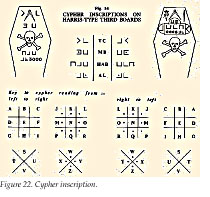 This is consistent with all the Reports prior, where there was a real antipathy in the Committee to having one standardized required Ritual. They felt their job was to clean up the confusion, and to make the draft available and let the Lodges agree to a written form of the Ritual as each Lodge saw fit.
That is not quite the way it turned out, because a resolution that was presented in the 1955 Grand Lodge Proceedings was to the effect that any Lodge working prior to June 1, 1954, would voluntarily adopt this Ritual but that any Lodge formed after June 1, 1954, practicing Canadian work had to use this agreed-upon Ritual.
This issue of required Rituals is far too complex for this paper, and it is obvious that people wanted to have some regularity rather than uncertainty. But the consequence, of course, is that it freezes everything in time such that, for example, in my Lodge, we are contemplating using candlesticks as compared to electric lights. There is general agreement that we can do this, and even come up with a piece of floor work that lights the candles in a certain order, but there is some question as to whether we can have any language used for this piece of floor work because it may not be found in the 1954 Ritual. This is consistent with all the Reports prior, where there was a real antipathy in the Committee to having one standardized required Ritual. They felt their job was to clean up the confusion, and to make the draft available and let the Lodges agree to a written form of the Ritual as each Lodge saw fit.
That is not quite the way it turned out, because a resolution that was presented in the 1955 Grand Lodge Proceedings was to the effect that any Lodge working prior to June 1, 1954, would voluntarily adopt this Ritual but that any Lodge formed after June 1, 1954, practicing Canadian work had to use this agreed-upon Ritual.
This issue of required Rituals is far too complex for this paper, and it is obvious that people wanted to have some regularity rather than uncertainty. But the consequence, of course, is that it freezes everything in time such that, for example, in my Lodge, we are contemplating using candlesticks as compared to electric lights. There is general agreement that we can do this, and even come up with a piece of floor work that lights the candles in a certain order, but there is some question as to whether we can have any language used for this piece of floor work because it may not be found in the 1954 Ritual.
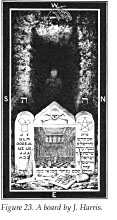 Seeing as how I'm talking about Ritual, it’s best to describe what actually happens in the Tracing Boards lectures in Canadian work. Typically, the Candidate is brought in after he’s been through the Ritual Work and has sat down in front of the Tracing Board. Usually in the First Degree this is somewhere between the Junior Warden Station and the Junior Deacon’s position. The Junior Warden then gives the lecture by pointing out all the elements of the Tracing Board. The other lodge members are on the side-lines watching this performance. This is a static and not particularly stimulating or participatory event. I know the Junior Wardens wouldn't describe it that way because of the amount of memory work involved. There are two different ways to deal with this. The first, if the Tracing Board is big enough, is to lay it flat on the ground and have all the Lodge Brethren stand around the Candidate while the lecture is being given. This is done in some English Lodges but it would be impractical for a number of reasons to do it in our Lodges. What has happened in a number of Canadian Lodges, including my own, is that when the lecture is given the Candidate is perambulated around the Lodge hall because almost every element of the First Degree Tracing Board is present in the hall itself. So rather than use the Figurative Lodge of the Tracing Board we indicate that the room that we're in represents most of the elements as outlined in that Board.
Similarly, in the Second Degree Lecture, the Candidate has already gone through the winding stairs and every other element of that lecture, by and large, is also in the Lodge hall. Pointing out the pillars that are usually situated somewhere near the west of the Lodge and all the material on the pillars, rather than referring to the Tracing Board involves the Candidate and shows not just the message of the Second Degree Lecture but also the fact that it is incorporated into the furniture of the Lodge.
As for the Third Degree, the Tracing Board Lecture is really only three lines long, but there’s so much that has gone on that night that it’s enough for the Candidate to absorb. I also recommend, speaking of Third Degree Lectures, the alternate Antient Lecture to be used for an educational night because it just contains so much worthwhile information and it is possible to re-create a Lodge Board or a Trestle Board and do a lecture that way.
This gets us finally to the issue as to whether or not we have to hide the Tracing Boards for the Degrees in which they are not being worked. There is nothing in our Ritual that requires any such thing. The usual reasons given for not having the Boards on display are reasons that occur because we don't have them on display as compared to reasons that would keep them from not being on display. For example, sometimes one hears that you need to keep the right Board out so that a member coming late to the Lodge knows what we are working in. Not a bad argument, except by that logic no one entering an Antient Lodge (where they don't use Tracing Boards) would have any idea of what they are doing. It is actually the Tyler’s job to tell the Brethren, and certain old English Lodges have affixed to the outer door a square and compasses, and it is the Tyler’s job to move the points of the compasses depending on what Degree you are in–this is a very sensible arrangement.
The other argument is that, by having the Second or Third Degree Tracing Board exposed to view when there is a Mason who has not yet attained that Degree, we are somehow imparting secrets. I think this has the secrecy argument placed on its head. We have the working tools out at all times, regardless of what Degree we are in and, we have both Pillars on display at all times and we don't take the tassels down after the First Degree. When I visited Kamloops Lodge No. 10 a few weeks ago, I noticed that all of their three Tracing Boards are attached to the wall so that as soon as you walk into the Lodge you see them all. I figure if it is good enough for at least one Past Grand Master and the present Deputy Grand Master, it is good enough for me. On that point, I'll leave this topic. I trust that this exposition has been of worth and interest. Seeing as how I'm talking about Ritual, it’s best to describe what actually happens in the Tracing Boards lectures in Canadian work. Typically, the Candidate is brought in after he’s been through the Ritual Work and has sat down in front of the Tracing Board. Usually in the First Degree this is somewhere between the Junior Warden Station and the Junior Deacon’s position. The Junior Warden then gives the lecture by pointing out all the elements of the Tracing Board. The other lodge members are on the side-lines watching this performance. This is a static and not particularly stimulating or participatory event. I know the Junior Wardens wouldn't describe it that way because of the amount of memory work involved. There are two different ways to deal with this. The first, if the Tracing Board is big enough, is to lay it flat on the ground and have all the Lodge Brethren stand around the Candidate while the lecture is being given. This is done in some English Lodges but it would be impractical for a number of reasons to do it in our Lodges. What has happened in a number of Canadian Lodges, including my own, is that when the lecture is given the Candidate is perambulated around the Lodge hall because almost every element of the First Degree Tracing Board is present in the hall itself. So rather than use the Figurative Lodge of the Tracing Board we indicate that the room that we're in represents most of the elements as outlined in that Board.
Similarly, in the Second Degree Lecture, the Candidate has already gone through the winding stairs and every other element of that lecture, by and large, is also in the Lodge hall. Pointing out the pillars that are usually situated somewhere near the west of the Lodge and all the material on the pillars, rather than referring to the Tracing Board involves the Candidate and shows not just the message of the Second Degree Lecture but also the fact that it is incorporated into the furniture of the Lodge.
As for the Third Degree, the Tracing Board Lecture is really only three lines long, but there’s so much that has gone on that night that it’s enough for the Candidate to absorb. I also recommend, speaking of Third Degree Lectures, the alternate Antient Lecture to be used for an educational night because it just contains so much worthwhile information and it is possible to re-create a Lodge Board or a Trestle Board and do a lecture that way.
This gets us finally to the issue as to whether or not we have to hide the Tracing Boards for the Degrees in which they are not being worked. There is nothing in our Ritual that requires any such thing. The usual reasons given for not having the Boards on display are reasons that occur because we don't have them on display as compared to reasons that would keep them from not being on display. For example, sometimes one hears that you need to keep the right Board out so that a member coming late to the Lodge knows what we are working in. Not a bad argument, except by that logic no one entering an Antient Lodge (where they don't use Tracing Boards) would have any idea of what they are doing. It is actually the Tyler’s job to tell the Brethren, and certain old English Lodges have affixed to the outer door a square and compasses, and it is the Tyler’s job to move the points of the compasses depending on what Degree you are in–this is a very sensible arrangement.
The other argument is that, by having the Second or Third Degree Tracing Board exposed to view when there is a Mason who has not yet attained that Degree, we are somehow imparting secrets. I think this has the secrecy argument placed on its head. We have the working tools out at all times, regardless of what Degree we are in and, we have both Pillars on display at all times and we don't take the tassels down after the First Degree. When I visited Kamloops Lodge No. 10 a few weeks ago, I noticed that all of their three Tracing Boards are attached to the wall so that as soon as you walk into the Lodge you see them all. I figure if it is good enough for at least one Past Grand Master and the present Deputy Grand Master, it is good enough for me. On that point, I'll leave this topic. I trust that this exposition has been of worth and interest.
|
|
![[Grand Lodge]](../../images/hedn.jpg)




